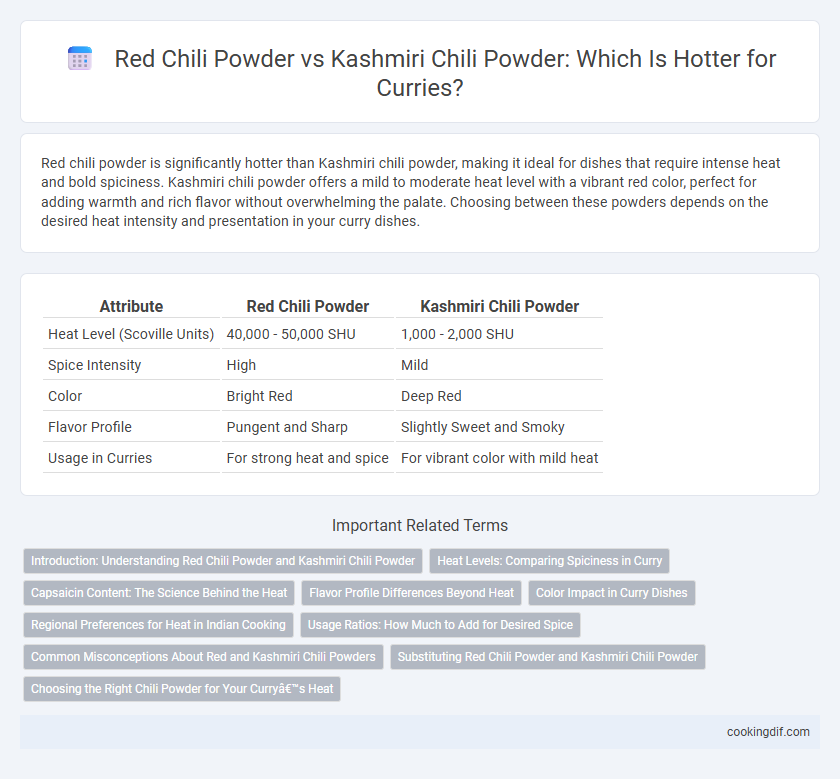Red chili powder is significantly hotter than Kashmiri chili powder, making it ideal for dishes that require intense heat and bold spiciness. Kashmiri chili powder offers a mild to moderate heat level with a vibrant red color, perfect for adding warmth and rich flavor without overwhelming the palate. Choosing between these powders depends on the desired heat intensity and presentation in your curry dishes.
Table of Comparison
| Attribute | Red Chili Powder | Kashmiri Chili Powder |
|---|---|---|
| Heat Level (Scoville Units) | 40,000 - 50,000 SHU | 1,000 - 2,000 SHU |
| Spice Intensity | High | Mild |
| Color | Bright Red | Deep Red |
| Flavor Profile | Pungent and Sharp | Slightly Sweet and Smoky |
| Usage in Curries | For strong heat and spice | For vibrant color with mild heat |
Introduction: Understanding Red Chili Powder and Kashmiri Chili Powder
Red chili powder and Kashmiri chili powder are essential spices in Indian cuisine, each offering distinct heat levels and flavor profiles. Red chili powder typically delivers a sharper, more intense heat, derived from dried red chilies such as Byadgi or Guntur varieties, while Kashmiri chili powder provides a milder heat with a vibrant red color, sourced from the Kashmiri chili known for its subtle warmth and smoky undertones. Choosing between these powders impacts the spiciness and color of a curry, making an understanding of their heat scale and culinary uses crucial for authentic flavor balance.
Heat Levels: Comparing Spiciness in Curry
Red chili powder typically delivers a higher heat level due to its concentrated capsaicin content, making it ideal for those who prefer spicy curry dishes. Kashmiri chili powder, on the other hand, offers a milder heat with a vibrant red color, enhancing the curry's appearance without overwhelming spiciness. Choosing between the two depends on desired heat intensity and visual appeal in curry recipes.
Capsaicin Content: The Science Behind the Heat
Red chili powder contains significantly higher capsaicin levels than Kashmiri chili powder, making it much hotter and ideal for those seeking intense heat in curry dishes. Capsaicin, the active compound responsible for spiciness, varies between these powders, with Kashmiri chili powder offering a milder, more vibrant color without overwhelming heat. Understanding the capsaicin content helps chefs balance flavor and heat intensity, ensuring the perfect curry complexity.
Flavor Profile Differences Beyond Heat
Red chili powder provides intense heat with a sharp, pungent flavor, often overpowering milder spices, while Kashmiri chili powder offers a milder heat level paired with vibrant color and a subtle fruity, smoky undertone. The lower capsaicin content in Kashmiri chili powder contributes to its gentle warmth, enhancing dishes without overwhelming other ingredients. These distinct flavor profiles influence the choice of chili powder in curries, where balancing heat and aroma is crucial for authentic taste.
Color Impact in Curry Dishes
Red chili powder delivers intense heat with a sharp, fiery flavor, significantly amplifying the spice level in curry dishes. In contrast, Kashmiri chili powder offers a mild heat accompanied by a vibrant red color, enhancing the visual appeal without overpowering the palate. Using Kashmiri chili powder helps achieve a rich, bright hue in curries, making it ideal for dishes where color intensity is a priority alongside subtle spiciness.
Regional Preferences for Heat in Indian Cooking
Red chili powder typically delivers a sharper, more intense heat favored in South Indian cuisines such as Andhra Pradesh and Tamil Nadu, enhancing fiery dishes like Chettinad chicken. Kashmiri chili powder offers a milder, vibrant red color with subtle heat, commonly preferred in North Indian regions like Kashmir and Punjab to impart warmth without overpowering flavors, as seen in Rogan Josh. Regional preferences highlight the balance between heat intensity and color, influencing the choice of chili powder to suit local palates and traditional recipes.
Usage Ratios: How Much to Add for Desired Spice
Red chili powder typically has a Scoville heat rating between 50,000 to 100,000 SHU, making it significantly spicier than Kashmiri chili powder, which ranges from 1,000 to 2,000 SHU. When adjusting usage ratios, use about one-third the quantity of red chili powder compared to Kashmiri chili powder to achieve the same heat level while maintaining flavor balance. Kashmiri chili powder is favored for adding vibrant color with mild heat, making it ideal for curries requiring a subtle spice profile without overwhelming heat.
Common Misconceptions About Red and Kashmiri Chili Powders
Red chili powder is often mistaken for being milder than Kashmiri chili powder; however, red chili powder typically has a higher Scoville heat rating, making it significantly spicier. Kashmiri chili powder is prized for its vibrant red color and mild heat, commonly used to add rich color without overpowering spiciness. Many assume Kashmiri chili powder is just a different name for red chili powder, but its unique flavor profile and lower capsaicin content set it apart in curry preparation.
Substituting Red Chili Powder and Kashmiri Chili Powder
Kashmiri chili powder offers a milder heat level, around 1,000 to 2,000 Scoville Heat Units (SHU), compared to the intense heat of red chili powder, which can range from 30,000 to 50,000 SHU depending on the variety. Substituting red chili powder with Kashmiri chili powder in curry recipes reduces spiciness while enhancing vibrant color and subtle smoky flavor. For less heat and more visual appeal in curries, Kashmiri chili powder is an optimal alternative to fiery red chili powder.
Choosing the Right Chili Powder for Your Curry’s Heat
Red chili powder delivers intense heat with a sharp, fiery flavor, ideal for those seeking maximum spiciness in curry. Kashmiri chili powder offers mild heat and vibrant red color, enhancing visual appeal without overpowering the dish. Selecting the right chili powder depends on balancing desired heat intensity with color and flavor profile for your curry.
Red Chili Powder vs Kashmiri Chili Powder for heat Infographic

 cookingdif.com
cookingdif.com